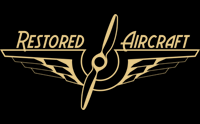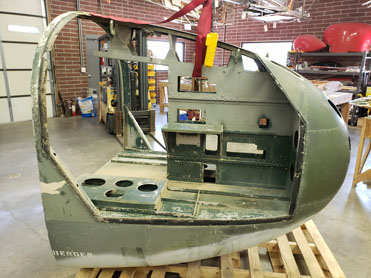B-25 8 Gun "Strafer" Nose Restoration
Evolution of the 8 Gun
The B-25 was developed as it was built. In short, that meant that the design was constantly being changed and improved. The early B-25s were neither heavily armed nor heavily armored. Both of these issues would gradually be increased with each successive model up to the pinnacle of B-25 production, the J Model. As a World War was being fought, differing theaters required different armament solutions. Knowing this, North American Aviation had field service representatives embedded with Bomb Squadrons all around the globe. Their purpose was to continually monitor the quality of North American products and provide feedback to the engineers at home for improvements in both quality and design.
Many "field modifications" supervised by these field service representatives did indeed make their way back into production. Most notable, were adaptations to the B-25s fire power. Early B-25C and D models did not have nearly enough forward fire power for many theaters. Field service representatives used spare .50 caliber machine guns and crafty mechanics to fashion early "cheek guns". The factory soon fabricated a kit to modify existing B-25s both in the field as well as modification centers around the globe. Eventually, those changes were made at the assembly line level. Another competing modification was the addition of several .50 caliber machine guns to the glass bombardier nose. These were mostly seen in the pacific theater as it was much easier to strafe a ship than bomb it from above. North American Aviation Field Service representatives worked with the legendary Pappy Gun on some of these modifications. Again, the suggestions were brought back to the factory, and another kit would be made to modify existing B-25s.
This is a great time to note that the 8 gun nose modification was ALWAYS a modification. They were not actually built at the plant, but modified there. There are photos of 8 gun nose B-25s that appear to be in the plant, but they are actually on the first part of the modification line. This is the reason that the block number on an 8 gun strafer is different. All blocks end in a 0, 1, or a 5. Anything else denotes a modification. For example, if a B-25J-20 is modified with an 8 gun nose, you may see it labeled as a B-25J-22. Although this is most common, it is not exclusive. If this plane were further modified, it may be changed to a B-25J-23. It is also worthy of noting that if you see a B-25J-22, it does not mean the B-25 carried an 8 gun nose. Sound confusing? Well, it certainly can be.
Our 8 Gun Nose History
So now you know that the 8 gun strafer nose came in a box with everything you need to modify your B-25H or B-25J. In reality, the noses could (and were) put on B-25C and B-25Ds as well. As it turns out, at the end of the war, there were many of these 8 gun kits setting in government warehouses around the United States. Our nose was one such kit. Many of the 8 gun kits were used in TB-25N conversions. When stripped of all the weapon systems inside, the big open cavity of an 8 gun nose was perfect for the addition of new radio, radar, and navigation equipment. Ours was placed on a B-25J-25-NC SN 44-30324 in 1954. It remained on that airframe until the winter of 1992 when replaced by a glass bombardier nose. During that time she was seen at many airshows as "I See No Problem" and then "Snow White II". It is in that paint that we found her quite literally sitting in the middle of nowhere for over 20 years.
Those that know the project, know that our mission is to preserve and honor the history of the B-25 and the men and women who built, flew, and maintain them; past, present, and future. To that end, our goal is to restore the nose to the condition that it would have left Kansas City in. This process will be slow and tedious, taking several years to complete. To complete it to the level we are going for will also be expensive. Many of the parts found inside an 8 gun nose are extremely rare, or in some cases just not available. Although we have already recovered a large amount of what is needed, we will have to remanufacture a good amount as well. Your donations will keep us working on this project. Our goal is to complete this restoration while we still have Rosies around to appreciate it. We can only do that with your help.
February 8, 2021 Update
Visible progress has been slow since we started work on restoring the 8 gun nose but much forward progress is being made. We have divided the restoration into phases. During phase 1, the goal was to get the stand designed in CAD and have it manufactured. The stand is being designed to replicate the stands used at the Kansas City plant to prepare the nose for attachment to the airframe. No stands remain from the plant, so design work was completed using our vast photo archive database. The design work is now complete and the steel we need should be here any day. We have also started working on removing many of pieces added to our nose during the mid-1950s modifications. Since no scale drawings exist of the 8 gun modification, progress here is slow going. Some of the material is obviously added, but some plates are less obvious. For historical integrity, we would like to keep the nose as intact as possible. Even the modification work was done with great quality, and removing some of the aluminum has required quite a bit of effort. We hope to have the remaining modification aluminum off with a few more work days.
Even before we recovered the nose, we were scouring the country looking for parts for the restoration. During the post-war modifications, all of the original equipment was removed from the nose and discarded. Some of what was removed was manufactured by North American specifically for the 8 gun nose, and some was off the shelf items. We have now acquired about 90% of the required parts that we have located. We are currently looking for a sponsor for one final purchase of the remaining pieces.
Since there are no scale drawings of the 8 gun nose, we are working with several experts to draw every original part we have collected in CAD. At the completion of this project, we hope to generate scale blueprints that can be used to replicate parts for the next 8 gun nose restoration. Every part is being meticulously documented, and that knowledge will be disseminated as we learn it. As an example, we were able to document the original marks from the glare shield on our nose. By documenting and carefully measuring it, we were able to definitively document a historically accurate glare shield pattern.
The last bit of update is likely the most exciting. We were able to locate and acquire a fully complete original compressor assembly. We have been struggling with this assembly for some time. We had acquired about 95% of what we needed to recreate one, but we were challenged by the frame it all went in. We only had one drawing of it that wasn’t to scale. This left several questions about size and how it was manufactured. When we brought the new assembly to the nose for a test fit, we were astounded by how it just fit right into place. We spent the next several hours discussing how this item has not just resolved one issue, but has led us in how to move forward with the next phase of the restoration.
September 19, 2021 Update
Much has happened since our February 2021 update. We have committed to a "historic" restoration. This means the focus is going to be to preserve as much of the original nose and parts as possible. We are certain there will be a need to reproduce a few parts, but as we progress, we will clearly note those pieces.
The majority of the nose has now been stripped. There are still a couple of areas that need some attention, especially on the inside. Ultimately, we have made the decision to do one more round of stripper and then clean up the final areas with dry ice blasting. This will eliminate the remaining paint without damage to the aluminum. We have also brought in the guys at the Dent Barn to use modern paint-less dent removal techniques to address over 75 years of dents and dings. This allows us to remove those dents without removing any of the skins, keeping even the original rivets intact.
As of September 15, the first parts to the stand were laser cut and welded together by our friends at Machine Head. The first piece of the stand completed was a stand-in for station 70. This is where the nose would attach to the plane. Although this isn't part of the original stand, it gives us an opportunity for a teaching moment. Our goal is not to create a "you-see-em" but a museum by telling the stories of B-25 history with artifacts and STEM programs.
Once the stand is built, we will put the nose on the stand and start the tedious work of putting it back together. Airparts, a local aviation supply company has signed on to help with the bits and pieces we need to start that process. We are currently working on a repair to the area cut out for a post war taxi light. The spent ammo and link access panel door is being fabricated. We will also be repairing rivet holes left from the post war installation of patches over the gun ports. Once we have all of these areas addressed, we can fully evaluate the need to protect the aluminum from corrosion. Unfortunately, this may mean painting the nose. We have a long way to go before that happens. There are only 2 more sponsorship slots available in 2021!
Platinum Restoration Sponsors







Silver Restoration Sponsors

If you would like to donate to the restoration fund for this project, please use the link below.













